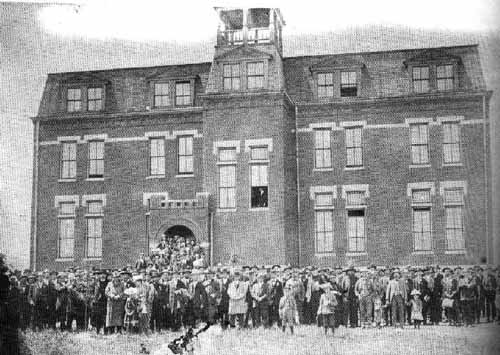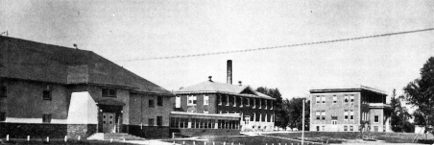Jewell Lutheran College
By Martin E. Nass
Transcribed for the IAGenWeb Project by Janelle Martin, with permission of Martin "Ed" Nass.
The Jewell Lutheran College Association was incorporated on April 11,
1893. The incorporation read "The said college shall be a Lutheran
College, but shall not be connected with any special synod. Religion
will be taught but it shall not be required. Capital stock of $10,000
which may be increased to $25,000 divided into shares of $100. No person
to hold more that ten shares." Officers of the association were: John
Thoreson, President; F. H. Alexander, Secretary, and William Anderson,
Treasurer. On Nov. 14, 1893, they purchased ten acres of land in the
College Addition of Jewell Junction, Iowa, from the Lyon Investment
Company for $180. The members of the board of directors were: Rev. C. J.
Eastvold, Rev. G. E. Gerstad, Rev. J. N. Sandren, E. E. Rorem, and Adolf
Molstre. A board of trustees were also named in the articles of
incorporation. They were: A. E. Hanson, N. J. Nelson, Ed Hanson, Ole J.
Olson, Richard Nelson, E. E. Rorem, N. K. Hill, Hans Underdahl, and Rev.
C. J. Eastvold.

The Association set about constructing a three-story building with a
full basement to serve as the college building. The basement housed
bathrooms, a kitchen, dining room, and laundry facilities. The first and
second floors were devoted to classrooms and administration. The third
floor served as the dormitory. The Aug. 18^th 1894 Stanhope Saturday
Mail reported that Prof. Vigness and N. J. Nelson wsere in Chicago last
week and purchased a complete supply of new furniture for the Jewell
Lutheran College. The Jewell Record of Aug. 25, 1894, reported that "The
dedication of the Jewell Junction Lutheran College will occur on Sept.
4^th . .. this will be the biggest day Jewell has ever seen for a number
of years." The Jewell Record for Nov. 3^rd 1894, reported the start of
the second term on Nov. 20^th . The advertisement states that the
"College Association owns $20,000 worth of real estate in Jewell and
differs in responsibility from the average school that nestles in the
rented upper story of general stores. The 1896 county atlas shows the
college grounds with only one building located at the north end of the
college grounds.
Faculty was hired and a schedule was organized to hold classes in four
terms; each was ten weeks long. The faculty consisted of L. A. Vigness,
President; M. D. Miller, Prof. of Mathematics; J. P. Peterson,
Commercial Department; Jessie Bucknam, Prof. Reading and Physical
Culture, and Lydia Klove, Music.
In 1894 there were 30 students enrolled at the college. The cost for a
student to attend a ten-week term was $27.50, which included room,
board, tuition, and books. The college soon began to experience
financial problems. Prof. Miller stated that he was promised a salary of
$400 for the year based on an enrollment of 20 students. This amount was
not paid in full. Miller began to question Pres. Vigness in board
meetings about his accounts and several expenditures. At the end of this
first, stormy year Miller and Peterson both resigned. The board then
decided to fire all teachers and vindicated Vigness. Vigness served one
more year before he left. Later he became the third president of St.
Olaf College in Northfield, Minnesota. The Aug 24^th 1905 Jewell Record
reported "… of last year's faculty, all but one could have been
retained: but under the circumstances the board deemed it best to engage
an entire new teaching force."
In 1895 the college enrollment was 39 students. The Stanhope Saturday
Mail in 1895 urged the people of Jewell to open their homes to provide
each student with comfortable living quarters. The course offerings were
expanded to include Arithmetic I, II, III, Higher Arithmetic, Geometry,
Grammar I, II, U. S. History, History of Education, Psychology, Science,
Art of Reading, Bookkeeping, Penmanship, Botany, Zoology, Rhetoric,
Civil Government, Latin, Vocal Music, and Physical Culture. The May 29,
1895, edition of the Jewell Record reported there was talk of organizing
a baseball club at the college.
The expenses of operating the college were more than the local
Association could handle, so they transferred the college property to
the Iowa District of the Hagues Synod on Nov. 9, 1897. This synod
included the states of Iowa, North and South Dakota, Minnesota, Kansas,
Illinois, and Texas.
In 1900, the college students organized an Athletic Association with
Prof. S. E. Dime as chairman. They laid out a baseball diamond on the
college property and organized a baseball team. A lawn tennis team was
also added.
In 1902, the college constructed a two-story ladies' dormitory just west
and south of the college building. The men continued to be housed on the
third floor of the main building. Then tragedy struck the college. A
fire on Dec. 2, 1903, burned the main college building to the ground.
Two men, Bertem Milang of Rose Grove Township and Julius Peterson of Red
Wing, Minnesota, died in the blaze. The fire was discovered by a student
named Britt, who arose at 5:00 a.m. to catch a train for his home in
Slater. When he descended the stairs he smelled smoke and retraced his
steps to alert the 22 boys who were sleeping on the top floor. All
hurriedly dressed and escaped, but it was later learned that Milang and
Peterson apparently returned to the building. The loss to the college
was $22,000.

College officials announced that classes would be held in the ladies'
dormitory until a new structure could be built. Completed in 1904, it
was a two-story building that had classrooms on the first and second
floors. A full basement was used for kitchen, dining, and laundry. The
men students were housed at various homes in Jewell, and the women moved
back into their dormitory. A year later a gymnasium was constructed to
the south of the dormitory. The college campus now consisted of four
buildings: a main building, a dormitory, a gymnasium, and the college
president's residence. The students organized both boys' and girls'
basketball teams, which played most of the high school teams in the area.
To gain more financial support the Hagues Synod transferred the college
to the Norwegian Lutheran Church of America in 1905. In 1917 the college
president, Knute Eittrem , reported to the Synod at a meeting in
Minneapolis that were were 72 students enrolled at the college. The
college continued to operate until the 1918-1919 school year when it
closed because of the war. On June 5, 1919, the Association met and
decided to re-open the college in the fall.
The Jewell Record of May 31, 1923, reported on changes in the faculty
for the next year. Roger Peterson and Prof. G. A. Larson resigned and
were replaced by Prof. H. D. Eittreim and Dr. L. M. (Jake) Jacobson. The
article continued to say that "the attendance the past year has been
only fair which caused friends of the school to be fearful as to the
financial outcome." This same year there was talk in Jewell about the
need for a new public school building. On Nov 2, 1923 it was noted that
the students had started to drive to school in cars. Elmer Charlson
drives over from Randall in his 'Star', Burton Olson drives another Star
from Wall Lake, and Helen and Irene Hove drive daily from Stanhope in
their Ford. On Jan. 11, 1923, the J. L. C. boys defeated Gilbert in
basket ball last Friday evening with a score of 30 to 21.
L. A. Vigness, by now Executive Secretary of the Norwegian Lutheran
church, learned of the plan and wrote a letter, dated Dec. 5, 1923, to
Mr. Henningson, Chairman of the Board of Education, stating that he
wanted to submit some suggestions regarding the Jewell Lutheran College.
He stated that, due to a reduced budget for the church, they were
"looking at the possibility that Jewell Lutheran College will be one of
those schools to discontinue their operation." He went on to say that
they were interested in negotiating a transfer of the college property
to the Jewell Independent School District.
The college continued until May 24, 1924, when the final commencement of
Jewell Lutheran College was held. Only seven students graduated that
year. They were: Winfred Bly, Sophia Froisland, Sophie Moline, Ellen
Olson, Hazel Hage, Clarence Hanson, and Bernice Sebby. According to
records stored at St. Olaf College, 4,236 students attended Jewell
Lutheran College during its 31-year history.
On June 19, 1924, a mass meeting was called for July 8^th at the college
in an effort to save the school. Two plans to be discussed were 1)
raising sufficient funds to purchase the college and operate it by the
local churches and 2) turning the college into a junior college.
Apparently neither plan was approved as nothing more was reported in the
Jewell Record. All four college buildings - Main, ladies' dormitory,
gymnasium, and the president's residence - were transferred to the
Independent School District of Jewell Junction, Iowa, on June 26, 1925,
by Warranty Deed for the sum of $45,000. The school district then used
the main building to house the high school and junior high. The ladies'
dormitory was transformed into a grade school, and the gymnasium was
used for its intended purpose. The president's residence became the
school superintendent's home.
Presidents serving the college were, in order: Lauritz A. Vigness,
Cornelius R. Hill, Meyer Brandvig, Victor H. Hegstrom, Olaf Q.
Skogeberg, Nels J. Lohre, Carl J. Eastvold, Knut O. Eittreim, Henry A.
Okdale, and Iver Iverson.
|